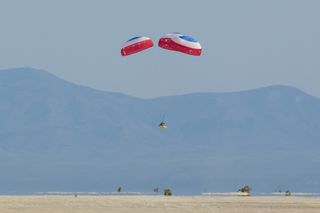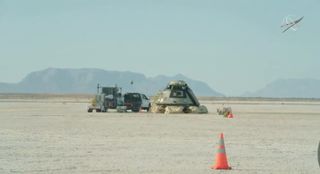Touchdown! Boeing's Starliner returns to Earth from space station
Starliner's crucial test flight is in the books.

Boeing's new astronaut taxi has landed safely back on Earth, wrapping up its long-anticipated and crucial demonstration mission to the International Space Station (ISS).
The Starliner capsule landed at White Sands Space Harbor, part of the U.S. Army's White Sands Missile Range (WSRM) in New Mexico, today (May 25) at 6:49 p.m. EDT (2249 GMT). The touchdown brought Boeing's uncrewed Orbital Test Flight 2 (OFT-2) to a successful end.
Starliner lifted off atop a United Launch Alliance Atlas V Rocket on the evening of May 19 and arrived at the ISS about 24 hours later. That was a huge milestone for Boeing, and one that the aerospace giant had tried to achieve once before.
Live updates: Boeing Starliner Orbital Flight Test 2 mission to ISS
Related: Boeing's Starliner OFT-2 test flight for NASA in amazing photos
Starliner launched on the original OFT in December 2019 but failed to rendezvous with the International Space Station as planned after suffering a series of software glitches. That previous mission also ended with a touchdown at the WSMR, albeit one that occurred sooner than expected. OFT-2 was Starliner's do-over, and a major hurdle to overcome in certifying the vehicle to carry crew.
Starliner undocked from the ISS today at 2:36 p.m. EDT (1836 GMT). At 6:05 p.m. EDT (2205 GMT), the capsule conducted a 58-second deorbit burn, which slowed its velocity by 285 mph (459 kph). Starliner detached from its service module a few minutes after the burn wrapped up and began its plunge through Earth's atmosphere at 6:33 p.m. EDT (2233 GMT), hitting our planet's air at about 17 times the speed of sound.
At 6:44 p.m. EDT (1844 GMT), at just under five miles (9 kilometers) in altitude, Starliner jettisoned its forward heat shield and deployed two drogue parachutes, slowing the vehicle's descent considerably.
Get the Space.com Newsletter
Breaking space news, the latest updates on rocket launches, skywatching events and more!
At an altitude of about 1.5 miles (2.4 km), the drogue chutes detached and Starliner's three main parachutes deployed, slowing Starliner to a manageable impact velocity. With about 3,000 feet (0.9 kilometers) to go, Starliner jettisoned its basal heat shield, exposing its airbags, which soon inflated to absorb the initial impact with the ground.
Terra firma touchdowns aren't the traditional norm for American orbital crew capsules; NASA's Apollo spacecraft and SpaceX's Dragon vehicle have both exclusively wrapped up their space missions with ocean splashdowns. (NASA's space shuttle orbiters — spane planes rather than capsules — were built for runway landings on terra firma; they sometimes came back to Earth at White Sands Space Harbor.)
NASA and Boeing identified four other potential landing sites leading up to Starliner's return, citing weather as the ultimate deciding factor. One of these alternatives was a different location within the WSMR, and the other sites were in Arizona, Utah and California.
But Starliner ended up landing exactly where and when it was supposed to, coming down within 0.3 miles (0.5 km) of its target, according to Boeing representatives.
Though OFT-2 is now officially a success, Starliner did experience a few hiccups during the mission. For example, two of the thrusters on Starliner's service module failed during its orbital insertion burn, which occurred about 30 minutes after launch. A backup thruster quickly compensated for the malfunctions, allowing the mission to continue without incident.

Shortly after that incident, mission team members expressed confidence that the thruster failures would not affect the remainder of OFT-2. They also stated that determining a root cause would likely have to wait until Starliner's post-flight inspections.
If those inspections and other analyses go well, NASA could end up certifying Starliner for crewed flight, potentially paving the way for an astronaut-carrying test mission to the ISS in the near future.
"We are getting our crewed test vehicle ready to go by the end of the year," NASA human spaceflight chief Kathy Lueders said in a prelaunch press conference earlier this month.
Boeing signed a multibillion-dollar contract with NASA's Commercial Crew Program in 2014. SpaceX inked a similar deal at the same time and has already launched four operational astronaut missions to the ISS with its Falcon 9 rocket and Dragon capsule.
Follow us on Twitter @Spacedotcom or on Facebook.
Join our Space Forums to keep talking space on the latest missions, night sky and more! And if you have a news tip, correction or comment, let us know at: community@space.com.

Josh Dinner is Space.com's Content Manager. He is a writer and photographer with a passion for science and space exploration, and has been working the space beat since 2016. Josh has covered the evolution of NASA's commercial spaceflight partnerships, from early Dragon and Cygnus cargo missions to the ongoing development and launches of crewed missions from the Space Coast, as well as NASA science missions and more. He also enjoys building 1:144 scale models of rockets and human-flown spacecraft. Find some of Josh's launch photography on Instagram and his website, and follow him on Twitter, where he mostly posts in haiku.
